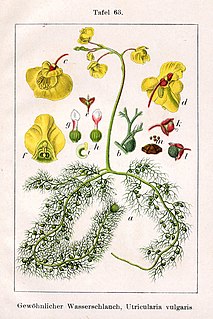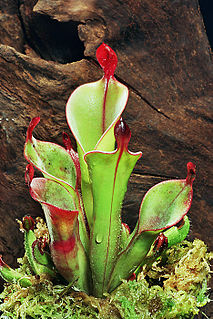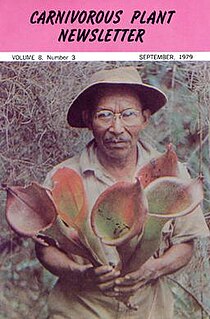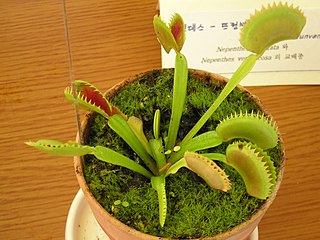
Utricularia, commonly and collectively called the bladderworts, is a genus of carnivorous plants consisting of approximately 233 species. They occur in fresh water and wet soil as terrestrial or aquatic species across every continent except Antarctica. Utricularia are cultivated for their flowers, which are often compared with those of snapdragons and orchids, especially amongst carnivorous plant enthusiasts.

Genlisea is a genus of carnivorous plants also known as corkscrew plants. The 30 or so species grow in wet terrestrial to semi-aquatic environments distributed throughout Africa and Central and South America. The plants use highly modified underground leaves to attract, trap and digest minute microfauna, particularly protozoans. Although suggested a century earlier by Charles Darwin, carnivory in the genus was not proven until 1998.

The genus Heliamphora contains 23 species of pitcher plants endemic to South America. The species are collectively known as sun pitchers, based on the mistaken notion that the heli of Heliamphora is from the Greek helios, meaning "sun". In fact, the name derives from helos, meaning marsh, so a more accurate translation of their scientific name would be marsh pitcher plants. Species in the genus Heliamphora are carnivorous plants that consist of a modified leaf form that is fused into a tubular shape. They have evolved mechanisms to attract, trap, and kill insects; and control the amount of water in the pitcher. At least one species produces its own proteolytic enzymes that allows it to digest its prey without the help of symbiotic bacteria.

Adrian Slack was a landscape gardener, plantsman, author and authority on carnivorous plants. He won 5 gold medals at the Chelsea Flower Show, and authored two books: Carnivorous Plants and Insect-Eating Plants and How to Grow Them.

The Carnivorous Plant Newsletter is the official publication of the International Carnivorous Plant Society (ICPS), the largest such organization in the world. It is headquartered in Walnut Creek, California.

A protocarnivorous plant, according to some definitions, traps and kills insects or other animals but lacks the ability to either directly digest or absorb nutrients from its prey like a carnivorous plant. The morphological adaptations such as sticky trichomes or pitfall traps of protocarnivorous plants parallel the trap structures of confirmed carnivorous plants.

The International Carnivorous Plant Society (ICPS) is a non-profit organization founded in 1972. It is the International Cultivar Registration Authority for carnivorous plants. As of June 2011, the society had around 1400 members.
Genlisea margaretae is a carnivorous species in the genus Genlisea native to areas of Madagascar, Tanzania, and Zambia. It has pale bundles of root-like organs up to about 20 cm long under ground that attract, trap, and digest protozoans. These organs are subterranean leaves, which lack chlorophyll. It had been known to possess the smallest known genome of any flowering plant as of 2006, but was later surpassed by the related species Genlisea tuberosa.

Utricularia inflata, commonly known as the swollen bladderwort, inflated bladderwort, or large floating bladderwort, is a large suspended aquatic carnivorous plant that belongs to the genus Utricularia. It is a perennial that is native to the southeastern coastal plains of the United States. It has often been confused with U. radiata, which is similar but smaller than U. inflata. Since 1980, U. inflata has been reported to exist in locations beyond its traditional range, such as the Adirondack Mountains in New York, southeastern Massachusetts, and in Washington State. Studies on the populations in the Adirondacks suggest that an introduction of U. inflata to a location where it naturalizes can lead to altered sediment chemistry by reducing the net primary productivity of native species. It is also listed by the state of Washington as a problematic species because of the dense mat-forming habit of this aquatic Utricularia. It is one of the few carnivorous plants that can be invasive.
Peter Geoffrey Taylor (1926–2011) was a British botanist who worked at Royal Botanic Gardens, Kew throughout his career in botany. Taylor was born in 1926 and joined the staff of the herbarium at Kew in 1948. He published his first new species, Utricularia pentadactyla, in 1954. In 1973, Taylor was appointed curator of the orchid division of the herbarium and, according to Kew, "under his direction, orchid taxonomy was revitalised and its horticultural contacts strengthened."
Utricularia cornigera is a large perennial carnivorous plant that belongs to the genus Utricularia. U. cornigera was described in 2009 by Miloslav Studnička based on his study of the variation in cultivated plants labeled Utricularia reniformis and apparent different geographic ranges. U. cornigera is found on Serra dos Órgãos in south-eastern Brazil and as of the new species' description, was not found in the presence of U. reniformis. Utricularia cornigera has been grown in cultivation under the name U. reniformis and with the cultivar name 'Big Sister'. It differs from U. reniformis by having 6-8 primordial leaves emerging from the seed during germination with a float and whorl of leaves. Utricularia cornigera also produces two distinct types of bladder traps that are dimorphic and it generally has larger leaves.

Dionaea muscipula 'Sawtooth' is a cultivar of Dionaea muscipula, the Venus flytrap that has deeply divided "teeth". It was formally described and registered as a cultivar in 2000.

The Journal of Insectivorous Plant Society is a quarterly Japanese-language periodical and the official publication of the Insectivorous Plant Society of Japan. The journal was established in January 1950. As of 2010, it was published in A4 format and totals around 120 pages annually. The English title has been used alongside the original Japanese one from the April 1986 issue onwards.

Planta Carnivora is a biannual periodical and the official publication of The Carnivorous Plant Society of the United Kingdom. Typical articles include matters of horticultural interest, field reports, and news of plant discoveries. The journal was established in 1980 and was called The Carnivorous Plant Society Journal until 2009; the following year it was combined with the society's newsletter to form Planta Carnivora. Issues are published in spring and autumn.

The Bulletin of the Australian Carnivorous Plant Society was a quarterly periodical and the official publication of the Australian Carnivorous Plant Society. Established in April 1982 as Bulletin / South Australian Carnivorous Plant Society, it continued publication until 2003. In a special general meeting of society members, in September 2004, it was decided the bulletin would cease publication. Typical articles included matters of horticultural interest, field reports, literature reviews, and scientific studies. The headquarters was in Adelaide.
Utricularia uxoris is a small epiphytic carnivorous plant in the genus Utricularia that is endemic to Costa Rica. It is distinguished from all other members of section Orchidioides in having green glabrous flowers with a white spur and its small size. The species is only known from its type locality in Reserva Biológica El Copal, Cartago Province. It was collected in 2004 by Jorge Gómez-Laurito, Diego Salazar, and Jorge Carmona and then formally described in 2005 by Gómez-Laurito (2005).

The Genus Utricularia: A Taxonomic Monograph is a monograph by Peter Taylor on the carnivorous plant genus Utricularia, the bladderworts. It was published in 1989 by Her Majesty's Stationery Office (HMSO) as the fourteenth entry in the Kew Bulletin Additional Series. It was reprinted for The Royal Botanic Gardens, Kew in 1994.

The Savage Garden: Cultivating Carnivorous Plants is a carnivorous plant cultivation guide by Peter D'Amato, horticulturist and owner of California Carnivores nursery. It was originally published in 1998 by Ten Speed Press, and reprinted in 2004. A revised edition was released in July 2013.

Carnivorous Plants of Australia is a three-volume work on carnivorous plants by Allen Lowrie. The three tomes were published in 1987, 1989, and 1998, by University of Western Australia Press.















